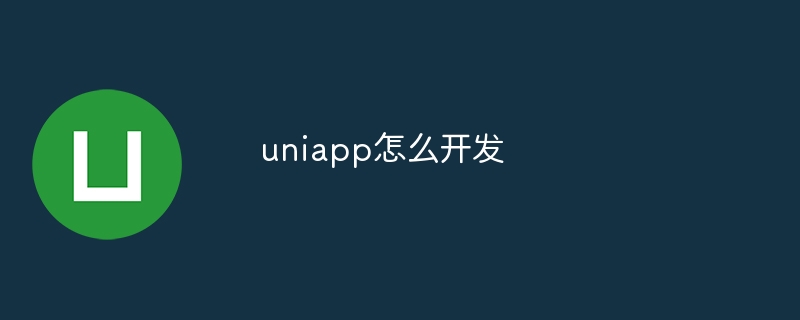How to develop uniapp
UniApp is a cross-platform development framework that uses JavaScript and a code base to build applications for iOS, Android, H5 and applets. Benefits include: Cross-platform: No need to write specific code for different platforms. Code reuse: Code can be reused across different platforms to improve development efficiency. Rich components: Rich built-in components simplify the development of common functions. Cloud IDE: Provides a cloud IDE to facilitate collaborative development.

How to develop using UniApp
Getting started
UniApp Yes A cross-platform development framework that allows developers to use one language (JavaScript) and a set of code libraries to build applications for iOS, Android, H5 and applets.
Advantages
- Cross-platform: Supports multiple platforms without writing platform-specific code.
- Code reuse: Code can be reused across platforms to improve development efficiency.
- Rich component library: Rich built-in components simplify the development of common functions.
- Cloud IDE: Provides cloud IDE to make collaborative development more convenient.
Installation
- Install Node.js.
- Install UniApp CLI:
npm install -g uniapp.
Create project
- Create an empty folder.
- Run in this folder:
uniapp init demo-app. - Enter the created project directory:
cd demo-app.
Development
UniApp uses Vue.js as the view layer and JavaScript and HBuilderX for development.
Structure
UniApp projects usually contain the following directories:
-
src: Source code directory, containing Vue components and JavaScript logic. -
manifest.json: Application manifest file, used to define application configuration. -
pages.json: Page routing file, used to define the page layout of the application.
Debugging
You can use UniApp Devtools or terminal commands for debugging.
Build and deploy
- Build the application:
uniapp build. - Deploy to target platform: Follow the platform-specific deployment instructions (such as Xcode for iOS or Android Studio for Android).
Other resources
- [UniApp official documentation](https://uniapp.dcloud.io/)
- [ HBuilderX IDE](https://www.dcloud.io/hbuilderx.html)
The above is the detailed content of How to develop uniapp. For more information, please follow other related articles on the PHP Chinese website!

Hot AI Tools

Undresser.AI Undress
AI-powered app for creating realistic nude photos

AI Clothes Remover
Online AI tool for removing clothes from photos.

Undress AI Tool
Undress images for free

Clothoff.io
AI clothes remover

AI Hentai Generator
Generate AI Hentai for free.

Hot Article

Hot Tools

Notepad++7.3.1
Easy-to-use and free code editor

SublimeText3 Chinese version
Chinese version, very easy to use

Zend Studio 13.0.1
Powerful PHP integrated development environment

Dreamweaver CS6
Visual web development tools

SublimeText3 Mac version
God-level code editing software (SublimeText3)

Hot Topics
 1378
1378
 52
52
 How to add functions to buttons for vue
Apr 08, 2025 am 08:51 AM
How to add functions to buttons for vue
Apr 08, 2025 am 08:51 AM
You can add a function to the Vue button by binding the button in the HTML template to a method. Define the method and write function logic in the Vue instance.
 How to use bootstrap in vue
Apr 07, 2025 pm 11:33 PM
How to use bootstrap in vue
Apr 07, 2025 pm 11:33 PM
Using Bootstrap in Vue.js is divided into five steps: Install Bootstrap. Import Bootstrap in main.js. Use the Bootstrap component directly in the template. Optional: Custom style. Optional: Use plug-ins.
 How to reference js file with vue.js
Apr 07, 2025 pm 11:27 PM
How to reference js file with vue.js
Apr 07, 2025 pm 11:27 PM
There are three ways to refer to JS files in Vue.js: directly specify the path using the <script> tag;; dynamic import using the mounted() lifecycle hook; and importing through the Vuex state management library.
 How to use watch in vue
Apr 07, 2025 pm 11:36 PM
How to use watch in vue
Apr 07, 2025 pm 11:36 PM
The watch option in Vue.js allows developers to listen for changes in specific data. When the data changes, watch triggers a callback function to perform update views or other tasks. Its configuration options include immediate, which specifies whether to execute a callback immediately, and deep, which specifies whether to recursively listen to changes to objects or arrays.
 How to return to previous page by vue
Apr 07, 2025 pm 11:30 PM
How to return to previous page by vue
Apr 07, 2025 pm 11:30 PM
Vue.js has four methods to return to the previous page: $router.go(-1)$router.back() uses <router-link to="/" component window.history.back(), and the method selection depends on the scene.
 Vue realizes marquee/text scrolling effect
Apr 07, 2025 pm 10:51 PM
Vue realizes marquee/text scrolling effect
Apr 07, 2025 pm 10:51 PM
Implement marquee/text scrolling effects in Vue, using CSS animations or third-party libraries. This article introduces how to use CSS animation: create scroll text and wrap text with <div>. Define CSS animations and set overflow: hidden, width, and animation. Define keyframes, set transform: translateX() at the beginning and end of the animation. Adjust animation properties such as duration, scroll speed, and direction.
 How to use vue pagination
Apr 08, 2025 am 06:45 AM
How to use vue pagination
Apr 08, 2025 am 06:45 AM
Pagination is a technology that splits large data sets into small pages to improve performance and user experience. In Vue, you can use the following built-in method to paging: Calculate the total number of pages: totalPages() traversal page number: v-for directive to set the current page: currentPage Get the current page data: currentPageData()
 How to query the version of vue
Apr 07, 2025 pm 11:24 PM
How to query the version of vue
Apr 07, 2025 pm 11:24 PM
You can query the Vue version by using Vue Devtools to view the Vue tab in the browser's console. Use npm to run the "npm list -g vue" command. Find the Vue item in the "dependencies" object of the package.json file. For Vue CLI projects, run the "vue --version" command. Check the version information in the <script> tag in the HTML file that refers to the Vue file.




